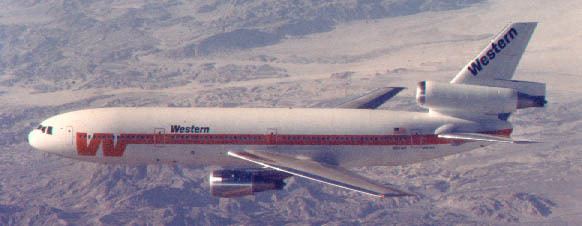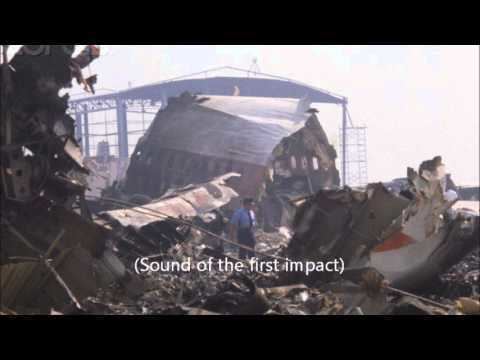Passengers 75 Survivors 16 Injuries (nonfatal) 14 Survivor 16 | Crew 13 Date 31 October 1979 | |
Summary Pilot error, Runway confusion Fatalities 73 (including 1 on the ground) Similar Pakistan International Airlines Fl, Alia Royal Jordanian Flight 600, Air New Zealand Flight 901, 1979 Dniprodzerzhynsk mid‑air co, American Airlines Flight 191 | ||
Western Airlines Flight 2605, nicknamed the "Night Owl" (Spanish: "El Tecolote"), was an international scheduled passenger flight from Los Angeles, California, to Mexico City, Mexico. On October 31, 1979, at 5:42 a.m. CST (UTC−06:00), the aircraft used for the flight, a McDonnell Douglas DC-10, crashed at Mexico City International Airport in fog, after landing on a runway closed for maintenance. Of the 88 people on board, 72 were killed in the crash; and one person on the ground, a maintenance worker, also died when the plane struck his vehicle.
Contents
- Aircraft and occupants
- Accident details
- Aircraft
- Ground
- Airport closure
- Accident investigations
- Sidestep approach
- Safety recommendations
- Notable passengers
- Lawsuit
- References

The event is the third-deadliest aviation accident to occur on Mexican soil, after the crashes of two Boeing 727s—the 1969 crash of Mexicana Flight 704 and Mexicana Flight 940 in 1986—and the seventh-deadliest accident involving a DC-10. The crash of Flight 2605 was one of three fatal McDonnell Douglas DC-10 accidents in 1979, occurring just over five months after the crash of American Airlines Flight 191 at Chicago's O'Hare International Airport and less than a month before the crash of Air New Zealand Flight 901 on Mount Erebus in Antarctica.

Aircraft and occupants

The aircraft involved was a wide-body McDonnell Douglas DC-10-10, registered N903WA. It was painted with Western Airlines's "DC-10 Spaceship" livery. With the Spaceship layout, the aircraft had 46 first class seats, and 193 coach seats. The aircraft first flew in 1973 and in six years logged a total of 24,614 flight hours. On the accident flight, the aircraft had 75 passengers and 13 crew on board. Flight 2605 was piloted by Captain Charles Gilbert, First Officer Ernst Reichel, and Flight Engineer Dan Walsh. The cabin crew consisted of Flight Attendants Kathleen Miller, Rob Pond, Don Richards, Larry Roundtree, Sharon Smith, Teresa Sugano-Haley, Regina Tovar, and Eduardo Valencia. Two Western Airlines Flight Attendants, Vicki Dzida and Jon Stockwell, were deadheading in First Class to Mexico City.
Accident details
Mexico City International Airport has two runways: Runway 23 Left (23L), and Runway 23 Right (23R). At the time of the accident, runway 23L had full instrument approach equipment, including an Instrument Landing System (ILS), while Runway 23R did not. On October 19, 1979, a notice to airmen was issued stating that Runway 23L would be closed until further notice for resurfacing work.
Western Airlines Flight 2605 was a red-eye flight. The October 31, 1979 flight left Los Angeles International Airport at 1:40 a.m. PST (UTC−08:00), and was scheduled to land well before sunrise in Mexico City. Conditions at Mexico City were foggy, with poor visibility and ceilings.

As Flight 2605 approached Mexico City International Airport, Mexican air traffic controllers cleared it for an instrument approach using the ILS of Runway 23L, with an expected landing runway of 23 Right. With runway 23L closed for maintenance, what air traffic controllers expected Flight 2605 to do was to perform what is known as a sidestep maneuver to the (open) runway 23R. This meant that the flight was to follow the instrument landing system's glide path toward Runway 23L, and, as soon as they sighted Runway 23 Right through the cockpit window, they would reorient their aircraft to land on it instead. Between the time of their beginning the approach and the crash, they were advised that the landing runway was 23R four times by approach control or the tower. In any event, the phrase "sidestep" or "sidestep approach" – common aviation parlance in the United States – was never used by Mexico air traffic controllers to describe the approach to Flight 2605. There was no published visual representation of the sidestep approach available to the pilots. Text remarks for the sidestep approach to 23R described only ceiling and visibility minimums.
Weather conditions were deteriorating during Flight 2605's instrument approach. A 5:00 weather report indicated visibility of 2-3 nautical miles depending on direction; by 6:00 AM, visibility was described as "zero". Flight 2605 was on short final to the closed runway at 5:42 AM. Cockpit voice recording audio of the last seconds of the flight indicated that the first officer and captain agreed that they were cleared for 23R (not the runway they were still on approach to). The captain further stated that they were in fact (still) on the approach to 23L. The crew decided to abort the landing at this point. The flight's first officer began to describe the ILS approach's missed approach procedure, a climb to 8,500 feet, in a "nonurgent, perfunctory manner". Before any go-around power was added, the flight touched down hard on the unpaved left shoulder of Runway 23L with more than 2 g of force, at 130 knots of speed.
The aircraft continued to roll well to the left of center of the closed runway. The flight's second officer now said to the captain, "No visibility here", and the captain exclaimed "Oh Jesus Christ!", presumably seeing a parked dump truck overlapping the left shoulder of Runway 23L that the plane was about to hit. Three seconds before impacting this dump truck, the crew did apply go-around power, attempting to leave the ground. The aircraft's nose was pulled up 10-11 degrees. Take-off thrust was not sufficient to lift the aircraft past the truck. The DC-10's right main landing gear impacted the hood of the parked dump truck, separated from the aircraft, and hit the right tailplane and elevator. The impact of the landing gear shattered the truck, fatally injuring its driver, and creating a debris field 400m by 100m in area.
The damaged aircraft, now airborne with takeoff thrust engaged, began to bank to the right. The bank angle increased until the flap of the right wing struck the cab of an excavator 1,500 meters from the runway threshold. The aircraft's bank angle continued to increase to the point that the right wing began to cut into the ground and taxiways nearby the closed runway; the flight's continuous right bank by now took it on a northward ground track. The end of the right wing eventually struck the corner of an aircraft repair hangar, causing damage to the hangar and also fracturing the DC-10's right wing. The aircraft spun around, and impacted into an Eastern Airlines service building north of both runways, 26 seconds after it initially touched down. This final impact caused the structural breakup of the aircraft, heavily damaged the two story reinforced concrete building, and caused a large fire. One part of the DC-10's right wing travelled well off airport grounds, impacting a residential building on Matamoros Street in the Peñón de los Baños colonia and causing a fire there as well.
Most survivors of Flight 2605 were found in a 20 foot long section of fuselage which did not burn. Survivors reported that large pieces of the building continued to fall onto the wreckage of the aircraft several minutes after the crash, as rescuers arrived on the scene.
Aircraft
The day of the accident, the status of the 88 persons on board Flight 2605 was reported as follows:
One more passenger died of his injuries in ABC hospital on November 18, bringing the total fatality count of passengers and crew on board the flight to 72. Of the 16 surviving passengers of the flight, 14 were injured.
As of November 6, three people on board who had died had not yet been identified or claimed, and the coroner's office was creating face models of those victims to make that possible. The rest were identified by nationality.
Ground
The count of ground injuries and fatalities were variably reported. Ground fatalities were reported from one (the driver of the truck parked on Runway 23L) to as many as three (the driver of the truck and two people in the Eastern Airlines building the DC-10 crashed into). As many as thirty people in all were injured, including those on the ground (airport ground personnel and local residents) injured by flying debris.
Airport closure
Mexico City International Airport was forced to temporarily close to flights due to the Western Airlines crash. 2,000 people were reported to have travelled to the airport to view the crash site and wreckage on Friday, November 2.
Accident investigations
As Flight 2605 crashed on Mexican soil, the accident investigation was carried out primarily by the Direction General of Civil Aeronautics (DGAC). Details of its findings are published in ICAO circular 173-AN/109. The probable cause of the accident was determined to be "Non-compliance with the meteorological minima for the approach procedure, as cleared; failure to comply with the aircraft's operating procedures during the approach phase, and landing on a runway closed to traffic."
A further investigation was carried out by the Air Line Pilots Association, and results summarized in the December, 1983 issue of Flying magazine. While the ALPA report conceded that at face value, the pilots of Flight 2605 had in fact landed on the wrong runway in the face of published minimums, it was published with the notion that the Mexican accident report was of "inadequate depth and detail" and contained "significant errors".
Sidestep approach
A primary point of disagreement between the official report as published by ICAO, and the ALPA study, was the wording and description of the failed sidestep approach to Runway 23R. The official report describes it thusly:
"As shown by the flight recorder trace, the aircraft stayed on the correct flight path to Runway 23 Right for most of the time between the outer marker "Metro Eco" and Mexico City International Airport, and only deviated to the runway closed to traffic (23 Left) when at a height of (600 feet) above the ground during its final approach."
600 feet AGL was the decision point at which the sidestep approach required Runway 23R to be in sight (and subsequently, to be visually navigated to using a sidestep maneuver). In continuing toward 23L below that point, by definition the crew was deviating from their cleared approach.
While acknowledging that the crew ultimately landed on closed Runway 23L despite published visibility minimums, the ALPA study discussed the fact that the crew was confused as to what the sidestep approach they were cleared for required of them. Further, it indicated that landing on the closed 23L required only that the crew continue the flight path they were already on (which was a straight-in ILS approach to 23L).
Safety recommendations
The accident and subsequent investigation prompted the release of NTSB Safety Recommendations A-80-59 and A-80-60. The recommendations required explicit published runway approach procedures for airport approaches involving sidesteps; and distribution of documentation of sidestep approach procedures in general.
Notable passengers
Lawsuit
Mark Lucoff, the sole heir to Kenneth Lucoff's estate and his brother, initiated a civil lawsuit for $18,000,000 against Western Airlines and McDonnell-Douglas in a Chicago circuit court. The lawsuit accused both entities of negligence leading to the death of his brother.
